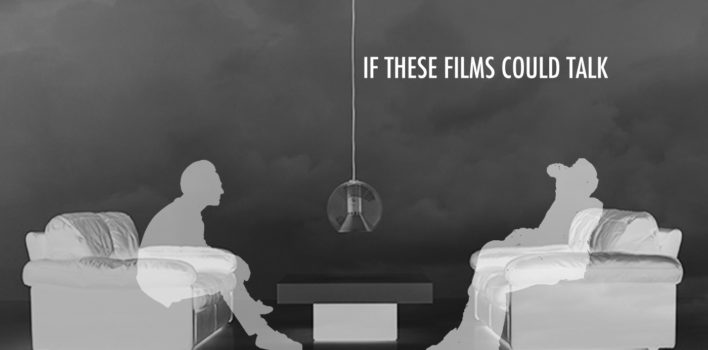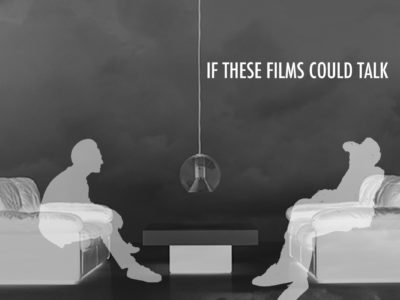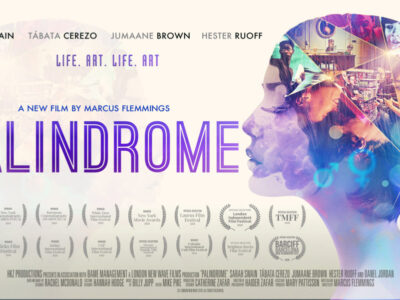Splitting the Divine Hares of Harvey (1950) & Donnie Darko (2001)
“We must all face reality sooner or later, Dowd.”
“Well, I have wrestled with reality for 35 years, Doctor, and I’m happy to state I finally won out over it.”
—Dr. Raymond Sanderson & Elwood P. Dowd, Harvey“Why are you wearing that stupid bunny suit?”
“Why are you wearing that stupid man suit?”
—Donnie Darko & Frank, Donnie Darko
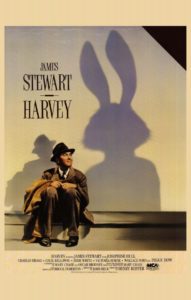 “Is the hare trustworthy?”
“Is the hare trustworthy?”
“Should we follow the white rabbit?”
“What will we find out if we follow it?”
Philosophers, theologians, musicians, authors and clever, young girls have all pondered this question of existence. Books like Alice’s Adventures in Wonderland and films like The Matrix have run the gamut of literalness in tackling it. Admittedly, no one has literally followed a hare down a hole—or chosen between a red or blue pill—and had their metaphysical and epistemological underpinnings upended, so the question will always be metaphorical. The white rabbit is a stand-in for something; the “key to life” or shakubuku: “the swift, spiritual kick to the head that alters your perception forever” as Debbie Newberry states in Grosse Pointe Blank. It’s the philosophical divina leporem. Even Captain Ahab sought the divine white hare, except his rabbit was a whale. The white rabbit is the transcendent revelation that shifts the way we view the world and ourselves in an utterly totalizing way. There is no crawling back out of the hole once we have chased the hare down it.
I used to watch the film, Harvey, quite a bit as a child. I was raised on films and television shows from the 40s-70s mainly. A man carrying an “imaginary friend” within the sacred bounds of adulthood was probably an ideal for many kids. This white rabbit was just as disruptive to the reality of the small town of the film as it is to the witnesses of childhood, parents and siblings. Everyone around has no idea what to do with it, yet the one who demands their metaphysical reality remains completely content with the experience—unless, of course, the child finds themselves in a horror film.
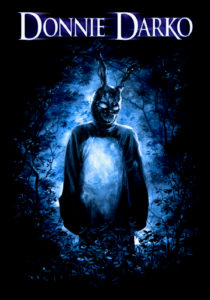 Elwood P. Dowd (played with comedic aplomb by Jimmy Stewart) goes about his simple, intentionally present life transitioning from his mansion to Charlie’s, a local bar, inviting the elite and the common folk of the town to dinner at his house. Normally, this behavior would not warrant the side-eyes and the sudden shifts across the street when people encounter him. However, there is something strange about Elwood. He is constantly accompanied by a white “pooka” hare that is six foot, three-and-a-half inches tall named “Harvey”—”now let’s stick to the facts” after all—that only Elwood, initially, seems to know is there.
Elwood P. Dowd (played with comedic aplomb by Jimmy Stewart) goes about his simple, intentionally present life transitioning from his mansion to Charlie’s, a local bar, inviting the elite and the common folk of the town to dinner at his house. Normally, this behavior would not warrant the side-eyes and the sudden shifts across the street when people encounter him. However, there is something strange about Elwood. He is constantly accompanied by a white “pooka” hare that is six foot, three-and-a-half inches tall named “Harvey”—”now let’s stick to the facts” after all—that only Elwood, initially, seems to know is there.
The “pooka” mentioned here comes from Celtic origins. The púca is a shapeshifter that often takes the form of an animal such as a goat, horse, cat, or hare, among many other animals. They can bring good or bad fortune to agricultural and marine communities and are often mischievous. The characters of the film do not uniformly come to a conclusion about the metaphysical status of Harvey, instead the film ties the narrative up into a nice bow with a humanist message about accepting the quirks of people because normality often entails a lack of kindness. Dowd is sacrificially kind. Foolish, even. While accepting people as they are is a decent message, the question of the white rabbit lingers in the background. Some experience Harvey, others don’t, and life goes on. The astute viewer is right to be bothered with this lack of resolution. How does life go on in the presence of a six-foot-plus walking white rabbit that inhabits our world?
Enter 2001’s Donnie Darko which finds young, troubled teenager, Donald ‘Donnie’ Darko (played by then-unknown Jake Gyllenhaal) navigating his own metaphysical exploration of angst and reality in the midst of pharmaceuticals, counseling, self-help gurus, Graham Greene and the 80s. He, too, sees a hare. However, his rabbit is more menacing, has bluish-gray fur, whispers of the end of the world, and is called “Frank.”
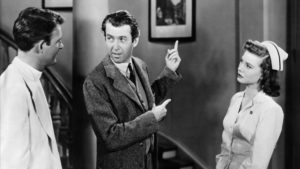 Donnie survives a freak accident when Frank draws him out of his suburban house to the country club golf links before a jet engine crashes into his family’s residence, hitting his room specifically. He would have died if Frank had not saved him. But Frank may not be all he is cracked up to be. As Frank’s presence grows more consistent, he causes Donnie to burst his high school’s water main and set fire to a local self-help guru’s mansion. His sanity seems to be in limbo as Frank becomes more prominent in his reality.
Donnie survives a freak accident when Frank draws him out of his suburban house to the country club golf links before a jet engine crashes into his family’s residence, hitting his room specifically. He would have died if Frank had not saved him. But Frank may not be all he is cracked up to be. As Frank’s presence grows more consistent, he causes Donnie to burst his high school’s water main and set fire to a local self-help guru’s mansion. His sanity seems to be in limbo as Frank becomes more prominent in his reality.
The characters inhabiting the narrative of Donnie Darko are much less ambiguous to the existence of Donnie’s imaginary friend. They don’t believe, they don’t even know he sees him. Donnie is the only one certain of his existence. He is isolated in his belief whereas Dowd is surrounded by people who have always seen him but not talked about it (his sister, Veta) or been converted by Harvey’s experiences (Dr. Chumley, the head of the sanitarium). Yet belief in Harvey changes nothing in the world of the narrative. The lowly cab driver in the final moments has just as much sway as Dowd or, even, a martini does in changing minds. Whereas Frank seeks to tear the world apart to reveal truth. Donnie is his prophet in a land of self-help easy-believism or unabashed unbelief in anything beyond Reagan-era materialism. Donnie takes the wine cup of fury from the hands of the divine hare and causes all to drink of it. They do not know it, but they will drink of it and stagger and go mad to the tune of Gary Jules’ cover of the Tears for Fears classic, “Mad World.” Thus sayeth the hare.
Dowd, however, seems to be able to keep the being of the divine hare at a distance. Admiring, even affectionate, but largely not bothered by Harvey’s presence. Dowd explains Harvey’s being to Dr. Chumley with a smirk:
“You see, science has overcome time and space. Well, Harvey has overcome not only time and space, but any objections… Well, you’ve heard the expression, ‘his face would stop a clock’. Well, Harvey can look at your clock… and stop it. And you can go anywhere you like, with anyone you like, and stay as long as you like, and when you get back… not one minute will have ticked by.”
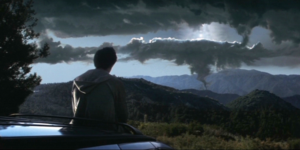 When Dr. Chumley asks Dowd if he’s ever been transported to a place by Harvey, Dowd answers in the negative. He’s never wanted to be or been happier anywhere than the town in which he lives. He merely chums around with Harvey and enjoys the local color. Harvey is a friend and drinking buddy, but Dowd does not seem to be moved by Harvey, to be changed by him. Like the rest of the inhabitants of his small town, Dowd is content remaining who he is. Veta remains a social climber. Dr. Sanderson remains essentially a Freudian psychiatrist who still sees Harvey as nothing more than a projection of Elwood’s past trauma even though Elwood provides evidence to the contrary—but doesn’t try very hard and does not seem interested in changing the doctor’s point of view.
When Dr. Chumley asks Dowd if he’s ever been transported to a place by Harvey, Dowd answers in the negative. He’s never wanted to be or been happier anywhere than the town in which he lives. He merely chums around with Harvey and enjoys the local color. Harvey is a friend and drinking buddy, but Dowd does not seem to be moved by Harvey, to be changed by him. Like the rest of the inhabitants of his small town, Dowd is content remaining who he is. Veta remains a social climber. Dr. Sanderson remains essentially a Freudian psychiatrist who still sees Harvey as nothing more than a projection of Elwood’s past trauma even though Elwood provides evidence to the contrary—but doesn’t try very hard and does not seem interested in changing the doctor’s point of view.
Donnie, though, is probably not the image of good divine witness, but his actions bring judgment and the purifying light of truth to the denizens of his town. Patrick Swayze’s guru, Jim Cunningham, is undone by Donnie’s actions when he sets Cunningham’s house ablaze, revealing the child pornography den hidden within its recesses. This revelation calls into question the freedom of the will that his philosophy expounded. One does not simply and effectively choose love over fear when recognizing the controlling internal and external forces this life throws at us. Donnie acts under Frank’s direction and light shines in the dark. And, strangely enough, Frank’s direction leads Donnie to the film’s climactic decision to go back in time and die under the crushing jet engine, so he can save the lives of his family and lover. A sacrifice. Something which Harvey never asked of Elwood. Instead, it’s Elwood’s own pleasantness that causes him to sacrifice for his sister. A sacrifice that he never goes through with and by which no one is changed forever.
Frank has different plans for Donnie.
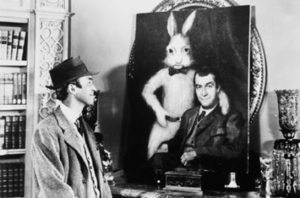 On the surface, the benevolent and playful Harvey seems like the imaginary rabbit one would want to encounter, the one most likely to bring tidings of comfort and joy and the sweetness of the gospel message to our ears. Frank would be voted most likely to materialize and slaughter a house-full of co-eds with an axe. His message feels darker, more driven by doom. It exposes the wrinkles in every person’s narrative of self. At the end of Harvey, everyone wins. Elwood is saved from becoming a “stinker”—”bastard” in the play—like normal people tend to be because of Harvey’s trickery. Veta comes to acceptance of Elwood’s quirkiness. Dr. Sanderson and Nurse Kelly kindle the romantic relationship lying below the surface during the whole film. And so on.
On the surface, the benevolent and playful Harvey seems like the imaginary rabbit one would want to encounter, the one most likely to bring tidings of comfort and joy and the sweetness of the gospel message to our ears. Frank would be voted most likely to materialize and slaughter a house-full of co-eds with an axe. His message feels darker, more driven by doom. It exposes the wrinkles in every person’s narrative of self. At the end of Harvey, everyone wins. Elwood is saved from becoming a “stinker”—”bastard” in the play—like normal people tend to be because of Harvey’s trickery. Veta comes to acceptance of Elwood’s quirkiness. Dr. Sanderson and Nurse Kelly kindle the romantic relationship lying below the surface during the whole film. And so on.
Donnie Darko leaves us in a much more sad, grief-stricken atmosphere. Certain characters are given life due to Donnie’s actions, but his family is left in shambles due to his death and the girl he loves doesn’t even know him in this new timeline. It’s a high cost that Frank asks Donnie to pay. He chose it voluntarily. Frank brought Donnie through a gauntlet of pain and suffering in order to arrive at his final act. Elwood never changed throughout the runtime of Harvey. Harvey did not exact that kind of sacrifice from him.
We find ourselves at a familiar junction. “Two roads diverging in a yellow wood,” two divine hares going down two diverging holes. Which rabbit do we choose to follow?
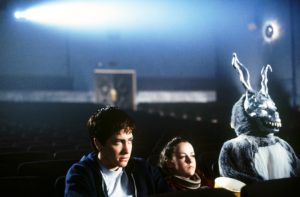 If we are honest with ourselves, most, if not all, of us would choose to follow Harvey. He is playful, he doesn’t ask much of us, he doesn’t expect us to change and those around us just need a slight shift in their perspective to make them be able to put up with us. He is accepting of us, inclusive even. Frank demands too much from us. He demands us to go to places and to reveal things to others and ourselves that would rather stay hidden. It is a hole that leads one towards judgment, suffering and sacrifice. What happens on the other side? We are changed. We are transformed through the judgment, pain and suffering and, in that space, we can find the love, grace and acceptance which, in turn, allows us to sacrifice ourselves for the good of others. Even to death.
If we are honest with ourselves, most, if not all, of us would choose to follow Harvey. He is playful, he doesn’t ask much of us, he doesn’t expect us to change and those around us just need a slight shift in their perspective to make them be able to put up with us. He is accepting of us, inclusive even. Frank demands too much from us. He demands us to go to places and to reveal things to others and ourselves that would rather stay hidden. It is a hole that leads one towards judgment, suffering and sacrifice. What happens on the other side? We are changed. We are transformed through the judgment, pain and suffering and, in that space, we can find the love, grace and acceptance which, in turn, allows us to sacrifice ourselves for the good of others. Even to death.
So, I guess I am saying that maybe the hare that seems the safest to follow isn’t actually the hare that is the best for us to follow. Maybe the hare that speaks prophetically—though looks like he might end up murdering you—is the one that “travels in God’s channel” like Donnie Darko states. It wouldn’t be the first time a person gave their lives for others voluntarily when they traveled through that same portal. Sometimes it means the salvation of the lives of those one loves and there is no greater sacrifice than this.


